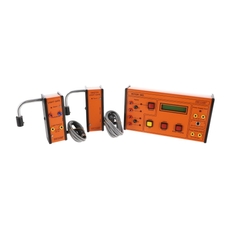Air Track Accessory Set
Air Track Accessory Set
Product code: G1530708
Product Description
This accessory set includes almost everything required to be used with Air Track (B8H25339). This set consists of the following parts, including the magnets useful for precision collision & non-collision study; these give better results than hook and loop attachment and spring set.
- Bolt & Wing Nuts x 10
- Spring Attachments x 4
- Springs x 4
- Hook & Loop Attachment Pairs x 2 Pair
- Pulley x 1
- String x 2
- Slotted Mass & Hanger: Weights 5 g - 4 pcs. & Hanger 5 g x 1
- Photogate Flags x 8
- Photogate Arms x 2
- Launching Cradle x 1
- Assorted Masses x 8
- Risers x 8
- Rubber Bands x 2
- Hook for Spring x 1
- Pins x 4
- Includes a full range of accessories to assist in the teaching of Motion and Forces when paired with an Air Track.
- Key Stage 3 Physics - Motion & Forces: Speed and the quantitative relationship between average speed, distance and time (speed = distance ÷ time). Forces being needed to cause objects to stop or start moving, or to change their speed or direction of motion (qualitative only).
- Key Stage 4 Physics - Forces & Motion: Explain the vector-scalar distinction as it applies to displacement, velocity and speed. Relate linear motion as observed from one moving vehicle to its observation from another moving. Make and interpret measurements of distances, times, speeds and accelerations,and represent these in graphical form. Recall Newton’s First Law and relate it to observations showing that forces can change direction of motion as well as its speed; identify and distinguish between these for forces which alter motion in everyday experience. Recall Newton’s Second Law and explain its status as the definition of inertial mass. Recall and apply Newton’s Third Law both to equilibrium situations and to collision interactions and relate it to the conservation of momentum in collisions. Explain that force is rate of momentum change and explain the dangers caused by large decelerations and the forces involved. Forces as vectors. Interpreting quantitatively graphs of distance, time, and speed. Estimating speeds and accelerations in everyday contexts.
When paired with a Linear Air Track, this accessory set can help your students explore and understand:
- Velocity and acceleration
- Newton's laws of motion
- Elastic and inelastic collisions
- Conservation of momentum in an ideal world, without the problem of friction - they can deal with that in later experiments!
This accessory set includes almost everything required to be used with Air Track (B8H25339). This set consists of the following parts, including the magnets useful for precision collision & non-collision study; these give better results than hook and loop attachment and spring set.
- Bolt & Wing Nuts x 10
- Spring Attachments x 4
- Springs x 4
- Hook & Loop Attachment Pairs x 2 Pair
- Pulley x 1
- String x 2
- Slotted Mass & Hanger: Weights 5 g - 4 pcs. & Hanger 5 g x 1
- Photogate Flags x 8
- Photogate Arms x 2
- Launching Cradle x 1
- Assorted Masses x 8
- Risers x 8
- Rubber Bands x 2
- Hook for Spring x 1
- Pins x 4
- Includes a full range of accessories to assist in the teaching of Motion and Forces when paired with an Air Track.
- Key Stage 3 Physics - Motion & Forces: Speed and the quantitative relationship between average speed, distance and time (speed = distance ÷ time). Forces being needed to cause objects to stop or start moving, or to change their speed or direction of motion (qualitative only).
- Key Stage 4 Physics - Forces & Motion: Explain the vector-scalar distinction as it applies to displacement, velocity and speed. Relate linear motion as observed from one moving vehicle to its observation from another moving. Make and interpret measurements of distances, times, speeds and accelerations,and represent these in graphical form. Recall Newton’s First Law and relate it to observations showing that forces can change direction of motion as well as its speed; identify and distinguish between these for forces which alter motion in everyday experience. Recall Newton’s Second Law and explain its status as the definition of inertial mass. Recall and apply Newton’s Third Law both to equilibrium situations and to collision interactions and relate it to the conservation of momentum in collisions. Explain that force is rate of momentum change and explain the dangers caused by large decelerations and the forces involved. Forces as vectors. Interpreting quantitatively graphs of distance, time, and speed. Estimating speeds and accelerations in everyday contexts.
When paired with a Linear Air Track, this accessory set can help your students explore and understand:
- Velocity and acceleration
- Newton's laws of motion
- Elastic and inelastic collisions
- Conservation of momentum in an ideal world, without the problem of friction - they can deal with that in later experiments!




